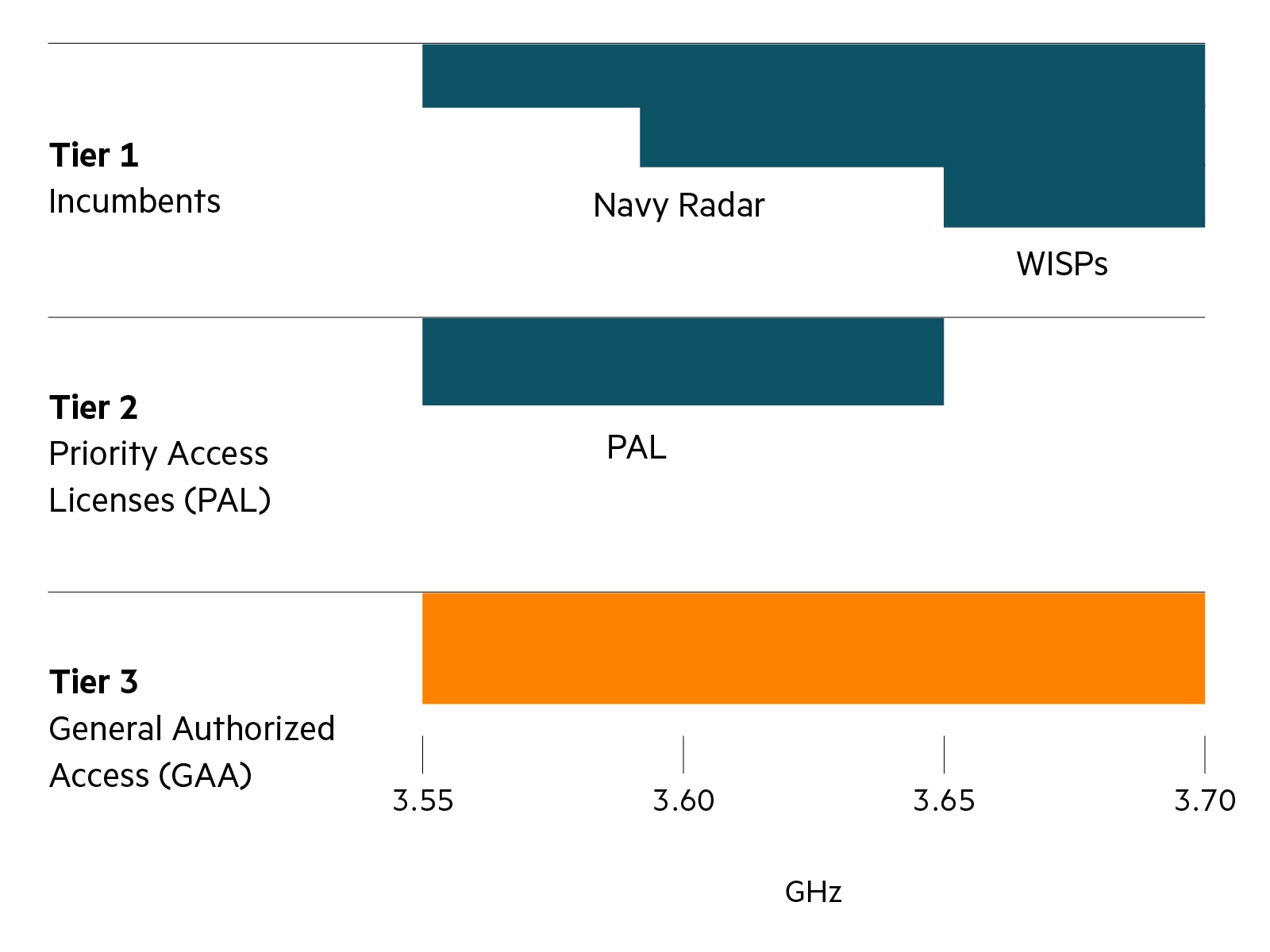
CBRS What is CBRS?
Citizens Broadband Radio Service (CBRS) refers to the unlicensed spectrum in the United States that can be leveraged for private 5G or private LTE networks. It consists of 150 MHz of spectrum in the 3.5 GHz band. Enterprise use of private 5G/LTE is growing to augment existing Wi‑Fi use cases where large area coverage, deterministic connectivity, or traffic segmentation is required.

- CBRS explained
- What is CBRS used for?
- What are the three tiers for CBRS?
- What devices support CBRS?
- Why CBRS?
- What do you need to deploy a private CBRS-based mobile network?
- Is it better to deploy a 4G or 5G network with CBRS?
- What are the vertical use cases for CBRS?
- Do CBRS private mobile networks use LTE or 5G?
- How do CBRS-based private networks compare to Wi‑Fi?
CBRS explained
CBRS or Citizens Broadband Radio Service is 150 MHz of spectrum (from 3.55 to 3.7 GHz) in the 3.5 GHz band (“Band 48”). Although CBRS connotes many things in the market, CBRS technically is 150 MHz (from 3.55 to 3.7 GHz) of United States-only spectrum and can be used for private mobile networks.
What is CBRS used for?
The primary uses for CBRS spectrum are:
- Macro extension, or providing additional wireless capacity for carriers’ macro networks, especially in urban settings
- Fixed wireless access (FWA) for backhaul
- Privately-owned and operated mobile networks for enterprises and municipalities. This page focuses on this use case, for enterprise private mobile networks.
What are the three tiers for CBRS?
The three tiers of users for this spectrum are:
- Incumbent, such as the United States Navy and fixed satellite
- Priority Access License (PAL), which are typically carriers that pay to license part of the spectrum
- General Authorized Access (GAA) such as unlicensed enterprises that utilize this spectrum for private networks.
Because these tiers concurrently share CBRS spectrum, the FCC requires that GAA users cannot interfere with PAL or incumbent users, and PAL users cannot interfere with incumbent users. A Spectrum Access System (SAS) is required to manage this potential interference.


What devices support CBRS?
Nearly all new cellular phones, such as Apple iPhones and Google Pixels, support the CBRS band. Laptops from Hewlett Packard, Dell, and Lenovo as well as tablets from Apple, Samsung, and Zebra also support this band. The ecosystem of CBRS-compatible devices will continue to grow.
Why CBRS?
The primary reasons enterprises deploy a CBRS network for private mobile networks are to:
- Improve wide-area outdoor coverage. CBRS-based cellular wireless covers more area per access point (AP) than a Wi‑Fi AP, but at a lower per-AP throughput.
- Improve network segmentation, or the ability to deploy a separate, overlay network that operates over relatively clean spectrum, especially for critical traffic, such as a manufacturing or an industrial network, a separate voice communication network for employees, or retail point-of-sale devices.
What do you need to deploy a private CBRS-based mobile network?
Deploying private LTE networks has traditionally been far more complicated compared to deploying an enterprise-grade Wi‑Fi network. Private cellular networks require a mobile core which manages the network, including device attachment, roaming between LTE small cells, and data plane traffic forwarding. Private cellular networks also require enterprises to provision and manage SIM (Subscriber Identity Management) cards or eSIMs for each device. Additionally, when using the CBRS spectrum, enterprises must integrate with FCC certified systems for Spectrum Access Service (SAS) to manage potential interference from neighboring radios.
New subscription-based services for CBRS are coming to market which integrate all these hardware and software components and are ready for enterprise IT network integration. This fully integrated solution considerably simplifies deployment compared to other competing solutions in the market.
Is it better to deploy a 4G or 5G network with CBRS?
It really depends what the end devices are and whether they support 4G or 5G. New combination 4G/5G cores can help enterprise migrate easily from 4G to 5G when ready.
What are the vertical use cases for CBRS?
Many different verticals are using CBRS to complement existing investments in wireless. Some examples are:
- Warehousing and distribution centers: wireless connectivity at greater range for autonomous vehicles and robots
- Healthcare: private mobile network connectivity for collaboration apps on smartphones assigned to staff
- Large public venues: network segmentation for backstage staff operations, reserving Wi‑Fi for guest services
- Retail: clean, dedicated spectrum for staff-operated, enterprise owned devices in congested store environments
- K-12 schools: connectivity to digital deserts with outdoor wireless backhaul to student homes
Do CBRS private mobile networks use LTE or 5G?
Today, CBRS private mobile networks frequently rely on LTE. However, in the future, it will also support 5G. When it supports 5G, we will see more CBRS-type implementations in Europe as well.
How do CBRS-based private networks compare to Wi‑Fi?
The CBRS band is intended to accommodate different cellular standards, including 4G (LTE) and eventually 5G, but not Wi‑Fi. All CBRS systems are currently based on LTE.
Enterprises are interested in CBRS as a way to augment, not replace, their Wi‑Fi systems. Key differences between CBRS and Wi‑Fi include:
- Coverage: An indoor CBRS LTE AP covers roughly 4x more than a typical indoor Wi‑Fi AP. Because CBRS operates in the 3.5 GHz spectrum, propagation is roughly the same as Wi‑Fi operating at 2.4 GHz or 5 GHz.
- Design: Deploying a CBRS system has traditionally been more complex than deploying a Wi‑Fi system, partially because of the requirement of components such as an EPC and a SAS.
- Cost: While CBRS-based LTE is a less expensive cellular solution than the traditional, small cell-based architectures, the per-AP price of CBRS is much higher than the typical per-AP Wi‑Fi price. However, CBRS’s greater coverage and lower associated cabling and installation costs somewhat close this gap.
